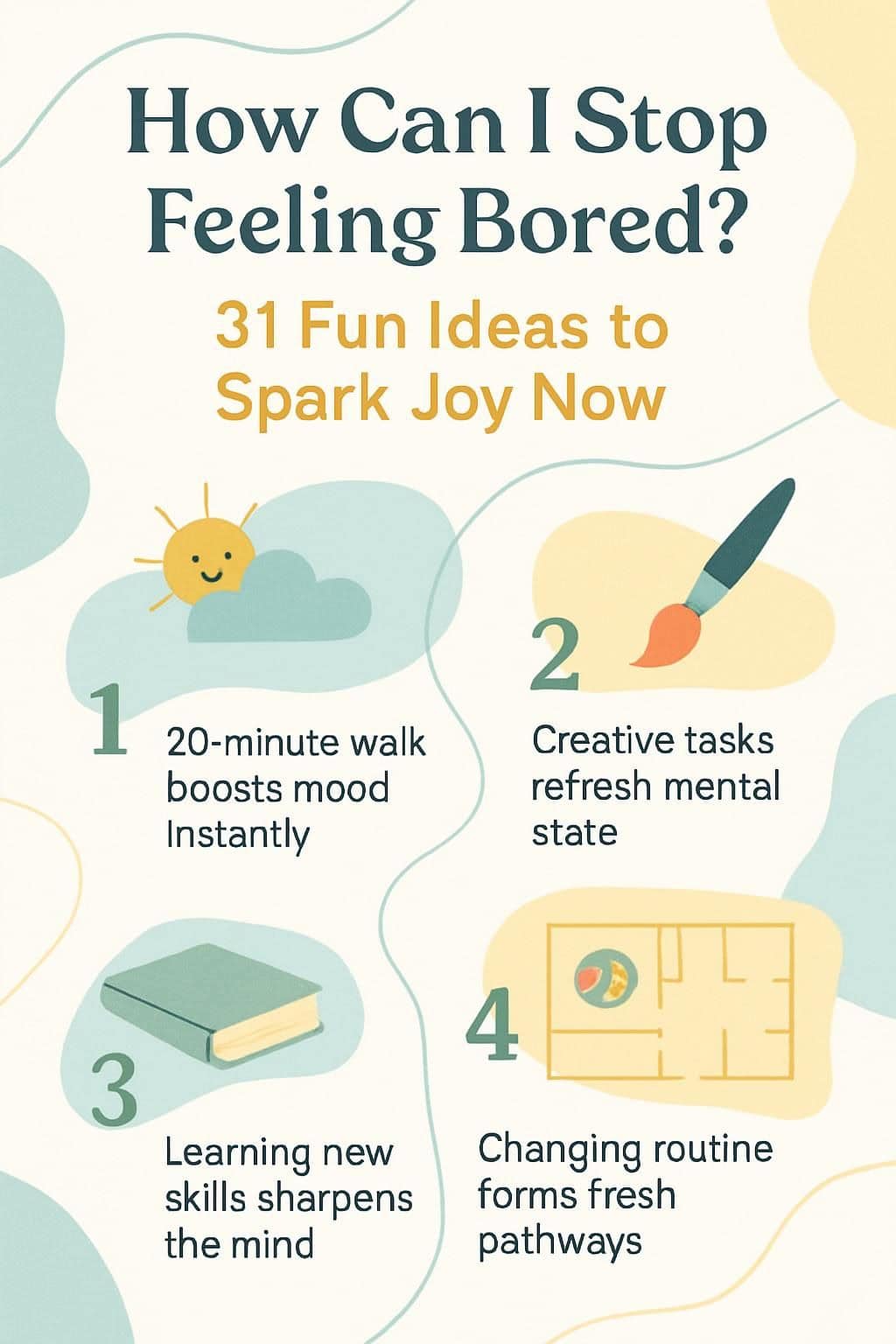Do you often ask yourself, “How can I stop feeling bored”? Chronic boredom can lower your productivity and motivation, hurting your mental health over time. This article offers 31 creative activities and useful coping skills to spark joy and boost curiosity in your daily life.
Keep reading to break free from boredom today!
Key Takeaways
Boredom kicks in as the brain craves action but can’t quite find it—often hinting you need something fresh, stimulating, or different to do.
Creative activities—like sketching, writing, snapping photos, or trying a new recipe—shake off dull moments and refresh your mental state.
Physical movement helps banish boredom too; even a quick 20-minute walk triggers happy brain chemicals, lifting your mood right away.
A simple shift in your daily routine or workspace forms fresh neural pathways, naturally boosting your mood without huge life changes.
Picking up new skills—cooking a new dish, exploring a hobby, or learning another language—sharpens your mind and gives you a sense of achievement.
Table of Contents
Understanding Boredom

Boredom hits us when our brains crave more action but can’t find it. This feeling often signals a deeper need for change or mental stimulation, which explains why our minds wander when we lack control over our time.
Defining boredom

Feeling bored is like wandering through mental fog—nothing grabs your attention or excites you. It often creeps in on rainy Sundays, making regular habits seem dull and flat. At its core, boredom sets in because your mind craves new stimulation but can’t find anything appealing.
At these times, your brain’s default mode network kicks into action, causing daydreams and restless feelings.

For many women, boredom signals deeper problems—like missing purpose and meaning in daily life. Extended boredom can even lead to symptoms of depression if it lingers too long. Fresh activities stimulate brain function, sharpening your mind and helping you avoid mental decline.
I’ve personally found simple tasks can quickly break the boredom cycle—a small project like planting a herb garden or even playing a few rounds at the best progressive slot machines online can truly brighten a dull mood.
Causes of boredom

Boredom can sneak up for many different reasons—here are the main factors that trigger it:
- Lack of purpose leads to boredom if tasks feel pointless or disconnected from your personal values. I once spent months filing paperwork nobody ever checked, and my motivation faded entirely.
- Daily routines that stay identical day after day can quickly become stale and boring. Eating the same breakfast, taking the same commute, and watching the same evening TV shows create an easy recipe for dullness.
- Too little stimulation can leave your brain hungry for more satisfying activities. Scrolling endlessly through social media rarely challenges your mind, leaving you restless and unfulfilled.
- Too much stimulation, on the other hand, can overwhelm you and cause boredom from mental exhaustion. Days filled with nonstop emails, texts, and phone calls can leave you too drained to do anything enjoyable.
- If your mind drifts frequently, staying engaged becomes difficult—making boredom more likely. Wandering thoughts pull your attention away from what you’re doing right now.
- Feeling stuck or lacking choices also sparks boredom and anxiety. Limited freedom turns even exciting activities into tiresome obligations.
- Social isolation boosts the risk of boredom because people naturally crave connection to feel stimulated. During recent lockdowns, many women reported increased boredom and symptoms of depression.
- Low physical energy from bad sleep or health problems also makes boredom more likely. Your physical condition strongly influences your ability to enjoy normal daily activities.
Lack of motivation

Motivation often fades during dull moments, trapping us in cycles of low drive. Many women find their energy sinking—even small chores suddenly feel tough to tackle. Your mind craves variety and fresh challenges to keep its spark alive.
Social interaction can also help lift spirits: chatting with a close friend or joining a casual group can quickly boost your energy.
Clear goals reduce the lack of drive. Simply jot down tasks you plan to do today, this week, or later this month. Splitting larger tasks into smaller pieces makes it easier to notice progress.
Also, physical movement brightens your mood and lifts energy levels—a quick walk outside or short dance session can shift how you feel. Cognitive Behavioral Therapy (CBT) methods help adjust negative thoughts that drain your motivation, letting positivity and drive return more easily.
Displaced psychological arousal

Boredom often arises from misplaced mental energy in your brain. It’s like having fuel—but nowhere to burn it—leaving you restless and stuck. Your mind craves something interesting, yet struggles to find a clear target.
Many women notice this feeling during big life shifts or stale routines that no longer feel rewarding.
Boredom is not the absence of energy, but energy without a home.
Physical signs include constant fidgeting, endless scrolling through Instagram or Facebook, or even mild anxiety—signals of energy stuck inside you. Brain imaging, like fMRI scans, reveals increased activation in specific parts of your brain during boredom.
That proves boredom isn’t caused by low energy—it’s energy in need of direction. Simple activities, like picking up a hobby or shifting your attention, can quickly refresh your mood and mindset.
Mind-wandering

Mind-wandering pulls your attention away from your current task. Your thoughts start drifting toward random memories, worries, or unrelated ideas—especially during tedious activities or whenever you feel tired.
Many women notice it happening during dull chores, meetings that drag on, or while reading something not so interesting. Your mind could suddenly shift to weekend plans in the middle of a conversation, or jump to tonight’s dinner plans as you drive home.
These brief mental detours can lead you to miss details, overlook key information, or forget what you just heard. Daydreaming can boost creativity, sure—but it also connects to anxiety, emotional stress, and general unease.
The goal isn’t to completely erase mind-wandering, but rather guide it gently and productively. Short meditation helps—taking a quick five-minute break can refocus a scattered mind.
Doodling quietly in a coloring book also calms restless thoughts and brings you back into the present moment. Some women jot down wandering thoughts as they arise, clearing mental clutter and regaining attention.
Social time matters as well; chatting casually with friends can snap you out of negative thought loops and improve your mood. Staying active, getting involved in enjoyable hobbies, and spending time doing things you love will further help keep boredom away from daily routines.
A lack of control

Feeling trapped in a dull routine often happens because you lack control over daily life. I felt this myself—it seemed each day was just a repeat of the one before. Boredom quickly seeps in if you can’t decide your own path or make important choices.
Staying stuck without control for too long can trigger mental health problems like anxiety and depression. Many women describe being pinned down by daily chores, with no time left for personal interests or growth.
But here’s something encouraging: even tiny steps can help you feel in charge again. Set aside just 15 minutes each day—for anything you want! Maybe it’s sketching or painting, squeezing in a short, energetic HIIT workout, or writing down your thoughts in a journal.
These brief periods, when you decide what to do, interrupt the emptiness boredom brings. Taking control, even in small ways, can lift your mood and improve emotional health.
Next up, I’ll share how creative projects can shake off boredom and infuse your days with fresh and positive energy.
Creative Ways to Overcome Boredom

Boredom can spark your creative side in ways you never expected. Your brain craves new activities that bring joy and fresh ideas to your daily life.
Lean into your creativity

Creative activities shake your brain awake and quickly chase away dullness. Your mind loves new ways to express itself—boosting joy and keeping personal goals on track. Here are fun, simple ways to get creative at home:
- Grab colored pencils and draw something easy in a sketchbook. Drawing, or art therapy, helps many women manage stress and emotions without any words.
- Write a short story about something funny that happened today. Writing creatively wakes up parts of the brain usually asleep in your daily routine.
- Take photos of five lovely but overlooked items around your home. Snapping pictures makes you notice small details and beauty in everyday things.
- Mix ingredients already in your kitchen to create a tasty new recipe. Cooking kicks your senses into action and gives you a delicious reward.
- Find old magazines and cut out images that show your dreams—then create a vision board. Visual boards help clear your mind and show clearly what you want from life.
- Start each morning by filling just one journal page with whatever’s on your mind. Daily journaling improves mental health and sparks creative ideas.
- Doodle freely while listening to music or chatting on the phone. Casual doodling opens new creative channels in your brain.
- Move furniture around in a room at home for a fresh feeling and a new view. Changes to your space can boost social interactions and mood.
- Use a free app to learn three easy phrases in another language. Learning languages builds brain pathways that help prevent mental decline.
- Create a playlist filled with feel-good tunes, and dance freely around the living room. Music and dancing instantly boost your mood and chase away sadness.
Try drawing or painting

Grabbing a paintbrush or pencil can quickly chase boredom away and boost your mental health. Adult coloring books make starting easy, especially if a blank page feels overwhelming.
Last week, I spent an hour doodling random shapes, and my stress melted faster than ice cream on a hot summer afternoon. With lines and colors occupying your thoughts, your mind gets a break from anxious worries or feelings of depression.
Art washes away from the soul the dust of everyday life.
Coloring pictures with crayons or markers offers a calm, relaxing pause in your busy day. You don’t have to be skilled or artistic to personally benefit from this calming activity.
Sketch favorite scenes from nature or draw characters you love from shows and books. Many women report feeling happier and more social after just 15 minutes of casual drawing, since it gives them something positive and enjoyable to talk about with friends.
This easy and fun habit can even help protect your brain from mental decline, adding happiness to your everyday routine.
Write a story, poem, or journal entry

Feeling stuck lately? Try picking up a pen and paper to get your creativity flowing. Many women enjoy writing stories about characters who tackle similar challenges to their own. Maybe your narrative centers on grief, desire—or another powerful feeling that deserves expression.
Free writing allows your mind to wander freely, without any strict rules holding you back. You can sketch out a short poem about nature, scribble journal reflections about your day, or simply jot down random thoughts.
Doing this often lifts your mood, and helps keep your mind sharp.
Your interests as a kid can offer clues about what might make you happy today. Did you enjoy creating stories back then? Why not give it another shot! Writing can act as therapy, minus the expensive appointments.
Scribbling down your emotions on paper, especially bored at night, beats endless scrolling on your phone. Many women say routine writing eases depression symptoms, lifts feelings of despair, and makes everyday life brighter.
Brainstorm innovative ideas

Grab an empty page and let your imagination run free—see what fresh ideas pop into your head. One afternoon, I scribbled down wild business concepts for fun. One idea turned into a weekend craft market that kept people smiling for months.
Your brain thrives on moments of creative thinking like this.
Give mind mapping a shot: write one central word (maybe “fun”) and branch out with related ideas around it. Or set your timer for 15 minutes, and quickly list 20 solutions to an issue bothering you—this fires up your brain, helps keep your mind sharp, and even boosts your mental health.
Try mixing two hobbies together for surprising results. Combine photography and hiking, perhaps, or cooking and music—creative mashups can lead to enjoyable new experiences. You can even get some friends involved: text someone close, toss ridiculous ideas back and forth, and watch your friendship strengthen.
The goofier your ideas, the stronger your sense of humor becomes. Something hilarious today could become your brightest idea tomorrow!
Explore photography or videography
Pick up your phone or camera and start snapping pictures of life around you. Photography is a refreshing way to shake off boredom—you don’t need any fancy equipment to begin. Last year, with only my phone, I discovered the excitement of spotting special moments hidden in ordinary places.
You can capture nature scenes, street life, or even set up your own tiny home studio with everyday items as props. Many women enjoy scheduling photo trips, giving their days a clear plan and something fun to anticipate.
Recording videos offers another entertaining way to stay busy and creative. You might shoot quick clips of neighborhood scenes, your pets getting playful, or even regular tasks around the home.
Inviting friends for casual photo sessions boosts your social life, too—we had a hilarious afternoon during a backyard fashion shoot a month ago. This hobby lifts your emotional mood, relaxes your mind, and shows you new talents along the way.
Keep things interesting by experimenting with fresh angles, trying new lighting setups, or picking different themes to explore.
Stay Active and Engaged

Boredom melts away when you move your body and shake up your surroundings. A brisk walk, dance party, or gym session can spark joy and boost your mental health in minutes.
Try invigorating exercise
Exercise quickly kicks boredom to the curb—and lifts your mood, too. Taking a brisk stroll through your neighborhood wakes you up and refreshes your mind. After just 20 minutes of moving around, your brain starts producing chemicals that naturally boost happiness.
Yoga is also a nice choice, pairing gentle stretching with breathing exercises. Many women swear by yoga breaks in the afternoon or simple stretches each morning, which restore both energy and concentration.
Moving your body isn’t simply about staying busy—it improves your health and your mindset at the same time. Turn up your favorite music and dance around your living room, or join an online workout class.
Even gardening can do the trick. Digging around your vegetable patch or planting some flowers gets you outdoors and active. Sunshine warming your skin and dirt under your nails bring a joy that screens just can’t offer.
Joining social events like group nature walks or tennis matches provides a chance to connect with others, boosting both mood and health in one go.
Redecorate your space
Giving your home a fresh look can boost your mood and chase away feelings of boredom. Try rearranging furniture to shape new pathways, or swap artwork between rooms for an instant refresh.
Adding an accent wall with vibrant paint—or hanging cozy string lights—can instantly uplift a room’s vibe. A few years ago, I painted my bedroom a soothing shade of blue, and it genuinely made me feel more relaxed each time I stepped inside.
Little details, like colorful rugs or bright throw pillows, offer affordable ways to spruce up your space. Plus, adding plants can brighten up empty corners and boost your mental health by cleaning indoor air.
Doing home projects is an enjoyable way to stay active—giving you something fun to do and lasting improvements to appreciate. Moving around while updating your space lifts your mood, and inviting friends afterward can strengthen social connections.
Next up, shifting your daily habits can also help curb feelings of boredom.
Mix up your daily routine
Feeling stuck, friend? It might be time to switch up your daily routine. Maybe take a fresh route to work—or enjoy breakfast somewhere different. Fresh routines create new neural connections in your brain, lifting your mood in small but powerful ways.
For instance, fix overnight oats instead of cereal, or trade your usual morning shower for a relaxing evening bath. Little shifts like these help keep your brain sharp and your body feeling healthier—without needing big changes.
You don’t have to do anything huge to break your routine. Shift your workout from morning to your lunch break, or swap scrolling social media for reading before bedtime. During TV hours, check in with a friend instead—your mind loves new experiences, and these minor adjustments offer just that.
Research shows women who regularly switch their habits lower their risk of eating disorders and gain better social skills compared to those keeping strict, predictable routines.
Plan a local or faraway adventure
Shaking up the same old daily routine helps, but sometimes you just need extra excitement. Planning something new gives you a goal, breaking that dull cycle for good. You don’t have to go far to find happiness nearby.
Local gems—like a cozy café you’ve never visited, a quiet park hidden nearby, or quirky thrift shops—make great mini-adventures right near home. Many women say physical activities, like walking nature trails or joining yoga groups, give them a fresh burst of energy.
Short outings like these often cost hardly anything, yet brighten spirits in big ways.
Maybe you’re ready for something bigger—like a weekend escape or a full vacation. Planning itself helps ease boredom, sparking joy as you research new places and build your itinerary.
While on your trip, pick up new skills tied to where you’re visiting—think cooking lessons while you’re in Italy, or surfing if you’re headed to Hawaii. These experiences boost your mental health, lifting your mood through fresh adventures.
Traveling shakes up old habits, leaving you with great memories that keep giving happiness even after you’re back home.
Pick Up New Skills

Learning new skills fights boredom and builds your brain power. You can pick up fresh talents at any age, from cooking to coding or even playing a musical instrument.
Learn to cook or bake
Cooking helps you beat boredom and discover joy. You build useful skills, spend less money eating out, and enjoy healthier homemade meals. For lots of women, paging through old family recipes—or tackling tricky pasta dishes—sparks surprising creativity.
Making something with your hands, like a cozy pot of soup on a chilly afternoon or a batch of chocolate chip cookies, provides focus and satisfaction. Your mental health gets a boost from this hands-on activity as you measure ingredients, mix flavors, and create tasty outcomes.
Check out cooking shows on TV or sign up for online cooking classes to freshen up your skills. The kitchen can become your stress-free zone, chopping fresh vegetables or kneading soft dough.
A little kitchen time can lift your spirits, improve your physical condition, and offer you tasty treats to share with loved ones. After getting comfortable with regular recipes, explore dishes from different cultures—you might discover flavors you never knew existed.
Explore another culture or language
Learning a language fills your downtime with joy and purpose. It sharpens your mind while you master fresh words, phrases, and grammar. Many women enjoy Spanish, French, or Japanese courses for the brain workout—and the chance to meet new friends.
You can use free apps like Duolingo, or sign up for structured lessons at a local community center. And here’s an extra perk—language skills can even give your career a nice boost.
Exploring new cultures adds excitement to dull routines. Why not try your hand at making tasty Thai dishes, watching a fun Korean drama, or discovering amazing Italian songs? These experiences spark creativity and teach you about daily life in other countries.
A lot of women say they feel closer to people worldwide after exploring new cultural habits. Even something small—like sampling unfamiliar foods or celebrating holidays from another place—can quickly lift your spirits.
After absorbing all that cultural knowledge, you’re ready to stay active and involved in your daily life.
Take online courses or night classes
Boredom fades quickly as you explore fresh ideas and skills. Online classes provide an exciting break from daily routines, giving you practical knowledge you’ll use often. Just last month, I joined an online cooking course—now Tuesday nights are for whipping up dishes I never imagined I could master.
Platforms like Coursera and Skillshare offer plenty of courses covering all sorts of interests. You can pick up watercolor painting, coding, and everything in between, usually at low prices or even free.
These virtual classes connect you with others who have similar interests and struggles.
Local evening classes offer a chance to learn something new and meet friendly faces in your neighborhood. The community college near my home holds evening classes in photography, pottery, and languages, attracting women of different age groups.
Being part of these group activities improves mental health and helps you build friendships. Research shows engaging in new activities sharpens your mind and boosts your physical health too.
Your brain enjoys fresh challenges, and structured classes provide just the right spark—especially if daily life begins to feel too routine.
Start a DIY project
Online courses offer valuable skills, but hands-on projects make learning come alive. DIY projects wipe out dull moments—lifting your mood, aiding relaxation, and improving mental health.
Just grab some crafting supplies, kitchen tools, or everyday items, and make something unique. These DIY activities stir your creativity and give you practical, useful skills. Many women enjoy crafting handmade gifts, renewing worn furniture, or planting a small herb garden.
Your home can easily transform into a creative DIY studio. Painting a room or organizing closets provides both a fresh space and a rewarding sense of accomplishment. Artistic hobbies like painting or designing your own jewelry keep your mind active and spirits lifted.
For music lovers, picking up an instrument or assembling mood-boosting playlists can be enjoyable projects too. Social DIY activities, like craft sessions with friends, can create bonds with others who share your passions.
Even professionals in mental wellness agree—the physical tasks involved in DIY routines help clear stress, sharpen focus, and increase positivity.
Connect with Others

Human connection cures boredom fast – grab your phone to call an old friend, join a local club, or host a small dinner party to spark joy through shared moments.
Call an old friend
Calling up an old friend is a quick and easy way to boost your mood and banish boredom. Many women overlook how great it feels to reconnect and hear that familiar voice from the past.
Even sending a short email or a sweet handwritten note can break your usual routine and bring instant happiness. Plus, old buddies often stir memories of childhood hobbies or forgotten interests that once brought out your creative side.
Reaching out costs nothing more than a little time, usually pays off with hearty laughs, and reminds you of good times you shared together.
For an extra layer of fun, pick a classic movie to watch over video chat—or try some online games while you catch up. These shared activities form stronger bonds and keep the connection alive better than simple texting.
Studies from therapy practices confirm that keeping friendships active strongly supports good mental health and can even slow down cognitive decline. Chances are, your friend might feel just as bored as you—and she’d welcome the surprise of hearing your voice today.
Make new friends
Making new friends is the quickest way to beat boredom. I’ve discovered that sending casual emails or joining social groups quickly leads to fun connections. Local clubs or hobby-centered online groups offer easy ways to meet like-minded people.
Even writing letters and attending social events can fill idle hours with laughter, joy, and bonding experiences. Many women find meaningful new friendships through volunteer work—helping others while building positive connections.
These social ties help fight boredom, sure, but they also boost your mental health through regular, friendly interaction.
Try combining online methods with face-to-face meetups to expand your social circle. Coffee meets, workout groups, or book clubs give you direct contact with new people. Spending free time at these social events can turn boring days into exciting new experiences.
Professional networking events serve two purposes at once—you expand your career prospects, plus you meet potential friends along the way. Online support groups and therapy circles can connect you with people facing similar issues, creating bonds of trust and understanding.
Putting yourself out there socially reduces loneliness and adds more enjoyable moments into everyday life.
Host a gathering or event
Hosting a party fights boredom and builds social bonds at the same time. You can plan a simple dinner, game night, or themed bash that brings friends together for fun and laughter.
Social events create spaces for sharing stories and playing games that spark joy in everyone. Many women find that planning these get-togethers gives them a project to focus on, from picking snacks to creating the perfect playlist.
The act of bringing people together often reignites your own sense of purpose and happiness.
Gatherings don’t need to be fancy to be fun. A movie night with popcorn, a craft session with wine, or a potluck brunch all work great for connecting with others. These social activities help improve your mood and mental health through real human contact.
Group hobbies like cooking classes or book clubs can grow from these events, giving you ongoing ways to stay engaged. Joining a local club or community group offers even more chances to meet people who share your interests.
Join a local club or community group
Switching your approach from organizing personal events to joining local groups can lead to meaningful connections. Nearby clubs offer built-in social circles, letting you easily meet people with similar interests.
Last year, I became part of a local book club—and honestly, our Tuesday gatherings quickly became the highlight of my week! Groups like these keep boredom at bay by offering regular get-togethers, giving you something fun to look forward to.
Local community groups deliver more benefits than enjoyable activities alone—they also help strengthen your social safety net, lifting mental health along the way. Several women in my weekend hiking group admit the trails help them shake off workplace stress and refresh their minds.
Clubs let you comfortably try new hobbies too, whether that’s snapping photos or mastering delicious recipes. Many groups also organize physical activities like dance classes or team sports, mixing healthy exercise with casual friendships.
Activities like these can even ease that restless, uninterested feeling therapists sometimes point out as boredom-related.
Be Mindful and Present

Mindfulness pulls you away from boredom by focusing on the present moment. Your brain craves this kind of attention, which acts as a natural remedy for the restless feelings that often lead to seeking online therapy.
Practice mindfulness or meditation
Ease racing thoughts with short, simple meditations. Pick a cozy spot, close your eyes, and gently focus on your breathing for about five minutes. Doing this regularly builds greater awareness, helping you stay in the present, rather than drifting into boredom.
Many women use quick meditation breaks to replace their impulse to scroll mindlessly on social media during quiet times. Therapists often teach these strategies because they genuinely boost mental well-being.
If meditation feels new, try using a guided meditation app. These apps feature short sessions, perfect for beginners or anyone with a packed schedule. Calm voice instructions guide you step-by-step and gently direct your attention.
The apps encourage moments of calm, bringing small bursts of happiness to your routine and helping you appreciate life’s little details. With regular practice, you’ll likely notice a happier, more balanced mood.
Spend time in nature
Nature provides an ideal cure for boredom. Strolling through a lush park or wooded trail stimulates your mind and gets your body moving. Many women discover that spending time outdoors creates an unmatched sense of calm compared to indoor pastimes.
The colors, scents, and sounds of nature blend together, lifting your mood and chasing away dull feelings. Bring your phone along—you might capture striking photos of colorful birds, blooming flowers, or fascinating trees.
Snapping these pictures gives purpose to your outings, keeping your attention focused here and now.
Gardening offers another rewarding way to get outdoors, dig into the dirt, and watch your efforts bloom over time. Even without a big backyard, pots of herbs placed near a sunny window or on a porch can deliver great results.
The physical activity of planting and tending engages your muscles, while planning your small garden keeps your brain alert. Therapists often encourage short nature walks as part of their mood-boosting sessions.
Next up—let’s consider how staying physically active in other ways can also chase boredom away.
Try yoga or relaxation techniques
Yoga can be an amazing cure for boredom—and it boosts your mental health too. Last year, I started doing basic yoga poses, and suddenly my mind felt busy instead of empty. Deep breathing techniques in yoga lower stress and calm the brain.
Even 15 minutes of gentle stretching can completely lift many women’s moods. These mindful movements keep your mind and body active, together.
Relaxation exercises also help by giving your mind something to hold onto. Try counting each breath slowly for just five minutes—you’ll quickly feel your thoughts settle. Counselors often recommend these breathing exercises to fight boredom and increase focus.
Your mental health gets a nice boost as you learn to stay in the moment, rather than feeling trapped and restless. And the best part—you don’t need any special gear or equipment to get started immediately.
Now, let’s talk about how staying productive can help you beat boredom too.
Productive Activities to Stop Boredom

Turning boredom into action can boost your mood and clear your mind – from sorting your closet to tackling a home project, these tasks create instant results you can see and feel. Read on to find out how therapy sessions can help you find deeper meaning in daily tasks when simple fixes don’t work.
Declutter your home
A tidy home helps clear your mind—clutter increases stress and amplifies boredom.
Try these easy tips to make cleaning less stressful:
- Pick a small space first—maybe a single shelf or drawer—to get some quick and easy wins.
- Use a timer for just 15 minutes; short sessions help tasks feel manageable instead of overwhelming.
- Sort items into three clear groups—keep, donate, and trash—to simplify organization.
- Pause to consider if each item sparks happiness or has a genuine purpose in your life right now.
- Handle mail immediately by sorting it, and routinely shred unnecessary old paperwork to control paper piles.
- Group similar items inside labeled containers or bins—finding things quickly becomes an easy habit.
- Install wall hooks or shelves, adding vertical storage that keeps floors and surfaces clear.
- Give away useful things you no longer use—your donations help others and open up much-needed space.
- Snap before-and-after photos to visibly track your progress and celebrate the improvements.
- Create a daily habit of putting items back in their spots right after using them to prevent clutter buildup.
- Schedule regular emotional check-ins during cleaning; sometimes, sorting through belongings brings up unexpected feelings.
- Ask a friend to join you for support or even seek online counseling if you feel overwhelmed or stuck.
Create a to-do list and tackle tasks
To-do lists turn empty moments into meaningful actions—and keep boredom from creeping in. They add structure, put you in control, and sharpen your mind.
- Do a quick mental download of every task swirling around in your head—no editing or sorting just yet.
- Chop larger tasks into smaller, easy-to-manage chunks; swap out vague goals like “clean house” for clear steps like “wash dishes” or “vacuum rugs”.
- Apply the two-minute rule to grab quick wins—tasks under two minutes get done immediately, saving you from cluttering the list.
- Rank tasks by what’s important and urgent, skipping busy tasks that just feel good but don’t move things ahead.
- Assign set times to your tasks—specific time slots organize your day, helping you avoid aimless wandering or boredom-induced procrastination.
- Physically cross out tasks once done—the rush of dopamine boosts motivation and makes tackling the next task easier.
- Include self-care routines—small, joyful breaks like “read a book for 20 minutes” or “walk outside” help balance productivity and fun.
- Keep lists somewhere you easily notice—this gentle visual prompt keeps you on track, away from distraction and mental fuzziness.
- Cheer yourself on with each finished task—acknowledging little victories boosts confidence and keeps boredom away.
- Quickly review and update your list daily—the simple rhythm of refreshing your tasks protects your mind from falling into dull routines.
Bringing order to your digital files and inboxes feels just as rewarding as clearing piles from your desk and closet.
Organize your digital files or photos
Digital clutter drains your energy, just like a messy room does—it makes you feel overwhelmed and scattered. A tidy digital space helps you stay calm, in control, and easily find what matters.
Try these easy steps to maintain a stress-free digital life:
- Pick one specific time every week for digital cleanup—I love doing this Sunday afternoons over tea.
- Make clear, easy-to-follow folders with names like “Family Photos 2023”, “Tax Documents”, or “Work Projects”—this beats vague labels any day.
- Immediately delete duplicate pictures to keep your device and cloud storage from filling up.
- Use the search feature to locate similar images; then, quickly choose your favorites and ditch the rest.
- Back your most important files onto an external drive or cloud storage—this protects you if a device crashes unexpectedly.
- Rename your files using dates and clear keywords, saving you from scrolling endlessly to find something later.
- Organize images in albums around events—like “Summer Trip 2022” or “Emma’s Birthday Party”—to keep enjoyable memories easy to explore.
- Install apps that organize photos for you—they can automatically recognize faces or locations and do all the heavy lifting.
- Set regular calendar reminders for cleanup time so digital tidying becomes an easy-to-keep habit.
- If digital clutter seriously stresses you out, talk with a mental health professional—they can help you manage these issues better.
Explore new career or hobby opportunities
Feeling bored may signal that it’s time to find new, exciting challenges. Exploring your childhood interests often points you toward fresh career ideas you haven’t thought about yet.
For instance, many women who love painting or drawing turn their artistic hobbies into teaching roles or start small businesses. Others who enjoy organizing trips for friends find success planning vacations professionally.
Even volunteer work at local clubs gives you valuable experience that nonprofits highly value. Trying something new also boosts your emotional health—lowering stress and raising confidence.
Taking online language courses can stimulate new brain connections and reduce mental fatigue. Picking up Japanese or Spanish, for example, could spark happiness now and enhance your resume later.
Many women notice that a casual hobby to fight boredom gradually turns into a meaningful job change. It’s best to start small, choosing activities that interest you. Your next hobby might become the most satisfying career you’ve had yet.
For those facing longer-lasting boredom—talking with a professional counselor or therapist can offer useful strategies and support.
Seek Professional Help if Needed
 Chronic boredom is more than just feeling dull—it can cause real trouble for your health and productivity. People often overlook how ongoing boredom connects directly to issues like depression, irritability, and even substance abuse.
Chronic boredom is more than just feeling dull—it can cause real trouble for your health and productivity. People often overlook how ongoing boredom connects directly to issues like depression, irritability, and even substance abuse.
If boredom keeps holding you back, talking to a therapist can truly make a difference. And you can get that help right from your sofa, thanks to online therapy.
One helpful method is Cognitive Behavioral Therapy (CBT). CBT teaches you how to rethink boring situations, finding fresh ways to add meaning and interest to your days. A skilled therapist can walk you through practical tools, breaking boredom’s grip step by step.
The idea isn’t about keeping busy; it’s about creating a life that’s satisfying and filled with enjoyment. If boredom runs your routine, professional mental health support might be exactly what you need.
How Will Overcoming Boredom Evolve in 2025?

By 2025, ways to beat boredom will change dramatically—with more people embracing digital detoxes as a regular habit. Simple storytelling and traditional games will become favorite pastimes again.
Physical activities, like gardening, will also boom in popularity because they naturally uplift mood and benefit your body. Many women, for example, will join local community gardens to ease boredom and connect socially.
Behavioral health experts link this growing trend to findings that physical movement can reduce restless energy, a common cause of feeling bored.
Technology will still matter, but in smarter forms. Language-learning apps will provide quick, daily five-minute sessions easily fitting into tight schedules. Virtual reality tools will allow you to virtually explore vacation spots before you commit to booking your trip.
Digital psychotherapy apps will identify signs of lasting boredom early—then offer brief, handy exercises to refocus your attention. Apps for home reorganization will break down the decluttering process into small and doable steps, skipping stressful weekend-long overhauls.
The emphasis will evolve from mindless scrolling to active, satisfying experiences that genuinely improve your mood.
People Also Ask
What are some simple ways to stop boredom quickly?
Pick up a new language! Learning languages keeps your mind active and adds a cool new skill. You can find free apps, watch fun videos, or chat online with native speakers.
How does learning a language help get rid of boredom?
Studying languages defeats boredom by giving you an engaging goal. It beats mindlessly scrolling on your phone—plus, you can do quick five-minute sessions anytime, like when you’re stuck waiting somewhere.
Is picking up a new language an expensive hobby?
Not really. Plenty of language tools online cost nothing. Free videos, apps, and learning websites are easy to find. Libraries often have books and free language lessons too.
Can I still learn languages if I didn’t do well with them at school?
Definitely! Learning languages as an adult differs a lot from school. You pick topics you actually enjoy, and you set your own pace. Lots of people who had trouble in class find language learning more fun later in life, since they have control over what and how they learn.
